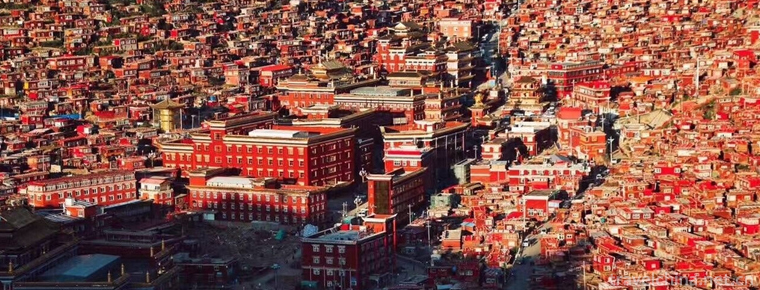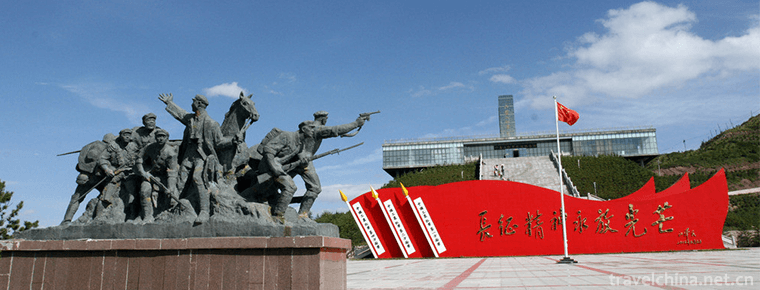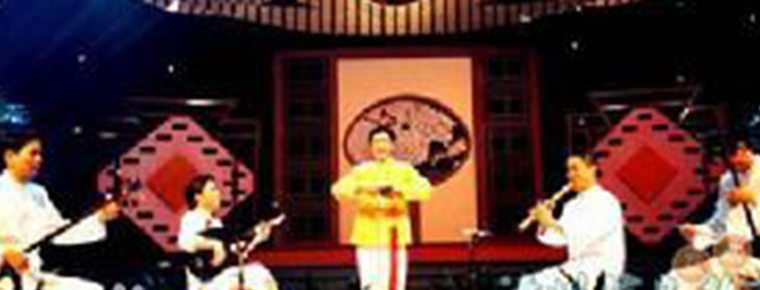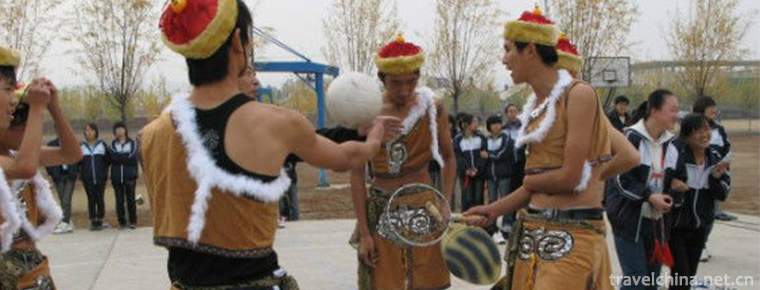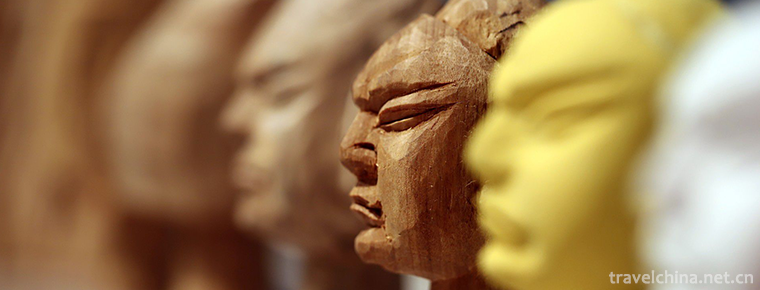Caogao Gong and drum in northern Sichuan
Caogao Gong and drum in northern Sichuan
Licao Gong and drum in northern Sichuan is a kind of traditional folk music. It mainly distributes in four counties and three districts of Guangyuan City, Sichuan Province, among which Qingchuan Grass Drum is the most representative. Grass drum is a kind of traditional folk culture widely spread in the northern mountainous areas of Sichuan Province. It is commonly known as "playing Gong and drum grass", "playing Gong and drum grass", "banishing Gong and drum grass". In July and August of each year, people usually sing a folk song when they weed corn grass and soybean grass together. Grass gongs and drums can not only ensure the progress and quality of weeding, but also make heavy manual labor easy in laughter, so that workers can fully enjoy the pleasure and happiness of labor.
On May 20, 2006, the dragon and drum in northern Sichuan were listed in the first batch of national intangible cultural heritage list with the approval of the State Council.
historical origin
Qingchuan County is located in the northern mountainous areas of Sichuan Basin, the junction of Sichuan, Gansu and Shaanxi provinces, known as the "home of giant pandas". Qingchuan grass gongs and drums are distributed in 36 villages and towns in the county. The grass gongs and drums in Banqiao Township, Daba Township, Qingxi Township, Sanguo Township, Debris Township and Maoba Township are the most distinctive.
artistic characteristics
Rich content
In July and August of each year, when weeding corn grass and soybean grass, several or dozens of households of labor force gather together, one person beats gongs, one person beats drums, while beating rhythmically singing, to inspire the morale of workers, unify the pace, eliminate fatigue. The gongs and drums are mostly local knowledgeable, prestigious old people or young people with cultivation prospects. The gongs are called "song Lang" and the drummers are called "joining hands" and "going the same way".
The process of a day can be roughly divided into: pulling strings, putting a lid (starting or choreographing), Anwufang (or worshipping Wufang), speaking the text, playing songs, and handing over. At about eight o'clock in the morning, when the Gong sounded, people were told that it was time to go out. Gongshou walking in front, the rest of the people heard the sound followed, gradually connected into a line in the mountain path, commonly known as "lead line". Arriving at the farming destination, the singer begins with a song and opens with a high-pitched voice in the accompaniment of gongs and drums. Next is "An Wufang". Some singers worship the five gods of east, west, north and south, while others worship heaven, earth and people directly. They pay attention to "time, place, people and people".
It takes up most of the day's work to speak the text. The content of the lyrics includes not only the compiled albums, but also the seven-character or cross written in a fixed format, which is spread orally among the people. In the special red age, Mao Zedong's seven laws and seven unique poems, Guo Moruo's seven-character poems have become the main content of the lyrics. In labor, if someone is found to be behind the times, the singer will come behind him and beat the gong and drum vigorously, encouraging and urging the outdated to catch up. The singer sings loudly and passionately, the laborer weeds quickly, and you chase after me, presenting a lively scene of drum music, song and laughter. Grass gongs and drums can not only ensure the progress and quality of weeding, but also make heavy manual labor easy in laughter, so that workers can fully enjoy the pleasure and happiness of labor.
Various forms
There are seven, nine, twelve and flower beats in the rhythm of cymbals and drums. Melodies and lyrics are divided into seven-character notation and cross notation according to the number of words. In addition, there are many kinds of tunes such as five-character notation and traditional lyrics and improvisational lyrics imparted orally. Singing works mainly include "Han Xiangzhuan", "Eight Immortals Tu", "Nautilus" and "Qingguantu", as well as some folk songs such as "Two-sided Willow Leaves" and "March Baicao Qing".
North Sichuan is rich in content, honest and plain singing and playing methods, with a long history of inheritance, and more than 10,000 oral lyrics. Its tunes are concise and lively, unique and highly appealing, which greatly enriches the cultural life of the people in the deep mountains. Protecting and inheriting the grass gongs and drums in northern Sichuan will certainly enrich and improve the Chinese folk music culture.
Representative works
Biography of Han Xiangzhuan, Eight Immortals Tu, Nautilus Ji, Qingguantu, etc.
Inheritance significance
"Grass Drum in North Sichuan" integrates folk culture and music into hard work. It is the crystallization of the wisdom of the working people in the mountain areas of North Sichuan, and it is also the precious cultural heritage left by the sages of past dynasties. Grass gongs and drums in northern Sichuan are an important part of folk culture in mountain areas of northern Sichuan, and are also excellent folk music culture left over by ancient sages. In the field work, the grass gongs and drums in northern Sichuan play the role of directing labor, activating the atmosphere on the spot and regulating the mood of the laborers. It has a straightforward and simple music personality, rich reserves of thousands of pieces of music, bright and concise vocabulary of music retains a large number of ancient physical labor in the music and cultural information, has a high academic research value.
Nowadays, due to the influence of modern production mode, the traditional production and lifestyle can hardly keep pace with the development of the times. The living space of the grass gongs and drums in northern Sichuan is shrinking day by day, and they are in danger of being lost. Old singers have passed away one after another, young people go out to work, a large number of labor migration, and the singer team is green and yellow. Therefore, the work of protecting and inheriting the grass gongs and drums in northern Sichuan has reached a critical moment.
The state attaches great importance to the protection of intangible cultural heritage. On May 20, 2006, the grass gongs and drums in northern Sichuan were approved by the State Council and listed in the first batch of national intangible cultural heritage lists.
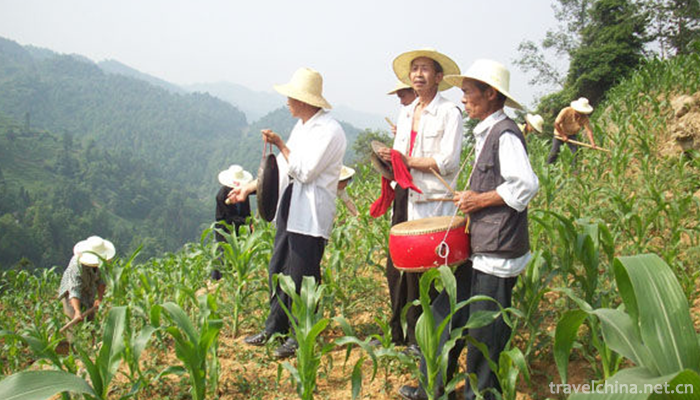
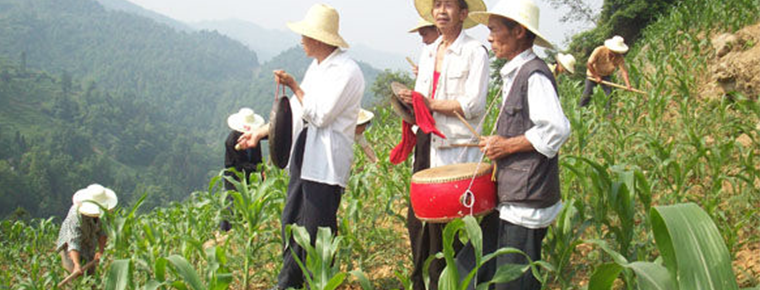
Caogao Gong and drum in northern Sichuan
-
Sertar County
Sertar County is a county under the jurisdiction of Ganzi ...
Views: 245 Time 2018-10-12 -
Jiulong Mountain Rural Tourism Scenic Area
Mianzhu Jiulongshan Rural Tourism Scenic Area is located in the northwest of Mianzhu City, Sichuan Province. It is a characteristic rural tourism area
Views: 154 Time 2018-12-22 -
Liupanshan National Forest Park
Liupanshan National Forest Park is located in the center of the triangle formed by Xi'an, Yinchuan and Lanzhou. It is located in the south of Ningxia. It spans two counties and one district in Jingyua
Views: 154 Time 2018-12-24 -
Thrush valley ecological tourist area
Thrushcross Valley is a natural eco-tourism area, located in Yaoshan Town, Lushan County, Henan Province, and at the northern foot of Yaoshan Scenic Area. It is a national AAAA-level tourist attractio
Views: 169 Time 2019-01-17 -
Brocade song
Brocade song, formerly known as Gezi or Shijin song, is also called begging tune. It was named Jinge in 1953. This is a form of singing accompanied by instrumental music.
Views: 347 Time 2019-05-07 -
Manchu Pearl Ball
Pearl ball is a traditional sport of Manchu, originally known as pearl picking, which originated from the ancient pearl picking production activities of Manchu. In the age of Taizu Nuerhachi in the Qi
Views: 302 Time 2019-05-20 -
Zhangzhou Puppet Head Sculpture
Zhangzhou puppet head carving is a traditional folk arts and crafts in Zhangzhou City, Fujian Province. It belongs to a special skill in the production of puppet stage props. Zhangzhou puppet head car
Views: 141 Time 2019-07-25 -
Huangshan University
Huangshan University, formerly known as the Huizhou normal school, was founded in 1978. In December 1997, it merged with the Huizhou Junior College of University of Science and Technology of China. It
Views: 140 Time 2019-11-17 -
Yinghua mountain
Yinghua mountain is located 37 kilometers northwest of Shifang City, Deyang City, Sichuan Province, 98 kilometers away from Chengdu. In 1986, it was designated as the first batch of provincial-level scenic spots, with a landscape area of 106 square kilometers.
Views: 205 Time 2020-11-05 -
Deyang scenic spot
There are Sanxingdui ancient Shu civilization sites in Deyang City, where a large number of national treasure level cultural relics such as bronze Dali Man, bronze mask, bronze sacred tree, gold stick and Bian Zhang were unearthed. There are also the pangtong
Views: 328 Time 2020-12-14 -
Neijiang in the new China period
From December 5 to 15, 1949, the people of Neijiang and other eight counties declared liberation one after another. In 1950, the office of Zizhong Commissioner moved to Neijiang and was renamed Neijiang special area. It has jurisdiction over Neijiang
Views: 251 Time 2020-12-16 -
Meishan primary industry
In 2019, the total sown area of crops is 318000 hectares, an increase of 1.1%. Among them, the planting area of grain crops was 196000 hectares, an increase of 0.6%; the planting area of oil crops was 58000 hectares, an increase of 1.8%; the planting area
Views: 344 Time 2020-12-18
